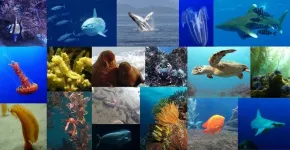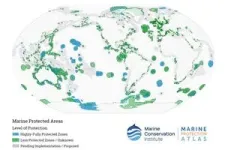(Press-News.org) (Santa Barbara, Calif.) — The countries of the world agreed: Our planet needs more protection from human activity. And with the globe facing an assortment of environmental crises, they realized the plan needed to be ambitious. Thirty-by-thirty was their proposal: protect 30% of the planet by 2030. But while conservation is popular in principle, the costs of actually enacting it often stall even the most earnest efforts.
Three researchers at UC Santa Barbara have proposed a market-based approach to achieving the 30x30 targets in the ocean. They tested whether a system that allowed countries to trade conservation credits could reduce costs, incentivizing nations to actually meet their goals. Allowing voluntary trade always reduced the cost of conservation, sometimes by more than 90%. The study, published in Science, is the first to draft and analyze a conservation market for achieving 30x30 targets in the ocean.
The 30x30 initiative is one aspect of the Convention on Biological Diversity, a multilateral treaty developed in the early 1990s. In fact, it’s target No. 3 of the larger Global Biodiversity Framework (GBF) adopted by the 196 countries that convened for the UN Biodiversity Conference in 2022. It calls for the effective protection and management of 30% of the world’s terrestrial, freshwater, coastal and marine areas by the year 2030 — a goal that many scientists say humanity must achieve to secure our planet’s long-term health. And while the GBF requires countries to commit to conservation targets, it does not outline which areas should be protected, how to do so inclusively or how to pay for it.
“This project started just over four years ago,” said co-author Juan Carlos Villaseñor-Derbez, who completed his doctorate at UCSB’s Bren School of Environmental Science & Management. At this point, countries were falling short of the 10% protection benchmark as they drafted plans for 30% protection. “It seemed like most nations were genuinely committed to marine conservation, but that the costs of conserving were preventing some from engaging in it at all.
“At the same time,” he added, “a lot of research had already shown that if you could get nations to cooperate around conservation, you could substantially reduce the costs of conserving.” He and his co-authors realized the world needed an institution, policy or framework that could support this.
Uneven costs and benefits
The cost of protecting acres of ocean is not the only aspect that differs from place to place. The ecological benefits of conservation also vary based on location. Achieving 30x30 in the ocean will require coastal nations to consider potential trade-offs associated with these protections. Because high-value fisheries can coincide with important marine ecosystems — such as coral reefs, seagrass meadows and kelp forests — meeting the obligation could come at a high cost for some nations but not others. “Without an innovative policy solution, the cost of conservation for many nations could stall progress toward 30x30,” said Villasenor-Derbez.
This variability means that trade could incentivize additional gains. Instead of investing in areas with high conservation costs, or low benefits, nations could exchange their duties to double down on regions where protection yields higher returns.
Environmental economists and scientists at UC Santa Barbara’s Environmental Markets Lab (emLab) wondered if a conservation credit system could help meet 30x30 targets in the ocean. They devised a system whereby nations could trade their conservation obligation with other nations through a “transferable conservation market” policy built around ecological principles.
“Like existing mandates, this approach requires every country to protect a certain fraction (say 30%) of its marine habitat,” said Distinguished Professor Christopher Costello, emLab’s director. “But unlike other approaches, we allow those obligations to be traded across countries, within strict ecological constraints.” In this way, countries with higher conservation costs pay others to increase their conservation efforts. This study estimates the potential global cost savings under various trading constraints.
“For example, Norway, which has valuable fisheries, might pay Palau, a country that has already invested significantly in coastal conservation, to conserve additional areas on Norway's behalf,” Costello said. This enables Norway to fulfill its conservation obligations in another part of the world.
Achieving 30x30 in the ocean
Costello, Villaseñor-Derbez and co-author Professor Andrew Plantinga developed a model to estimate the potential costs and benefits that could be achieved through a conservation market like this. They combined distribution data for 23,699 marine species with fisheries revenue data to build conservation supply curves for the world’s coastal nations.
They then defined “trade bubbles” based on biological and geographic factors. A country could trade conservation credits only with other nations within these predefined bubbles in order to ensure conservation was equitably spread across Earth’s different marine habitats. The authors examined five bubble policies that allow nations to trade within hemispheres, biogeographic realms, provinces, ecoregions, or globally, to determine potential costs.
Regardless of how they tweaked this setup, a market for marine conservation always reduced the costs of conservation. The model estimated savings could range from 37.4% all the way to 98% under the 30x30 target.
“It just highlighted how inefficient it is to require uniform conservation obligations from each nation,” Villaseñor-Derbez said. “After all, national boundaries don’t really overlap or line-up with the distribution patterns of marine biodiversity.”
Savings were highest in a global market, where every nation stands to gain from trade. But a global market could inadvertently focus conservation efforts on only a single type of habitat, neglecting others. That was precisely why the team introduced the trade bubble constraint.
“When nations facing large costs are allowed to trade, they can ask themselves ‘should I conserve in my waters at this high cost, or can I find someone in my bubble that has habitat just as good as mine but at a lower price?’” Villaseñor-Derbez said. The same would be true for a selling nation. They could decide whether to conserve more than they are required depending on the trading price.
Of course, a country could always go it alone, fulfilling their conservation obligations (and theirs alone) entirely within their own territory. Indeed, this is precisely how the 30x30 initiative currently looks. But the authors’ analysis suggests that very few countries will. Most find it far more economical to either buy or sell conservation obligations.
Conservation colonialism vs fair compensation
If a market system were established, some might wonder what would prevent wealthy nations from simply “paying off” their conservation obligations and offloading them onto poorer nations. For Costello, Villaseñor-Derbez and Plantinga, the market itself offers a solution. “All such exchanges are purely voluntary,” said Plantinga, who heads emLab’s Productive Landscapes Group. “The selling nation (the poor country in this example) only engages in trade if they find it advantageous.”
In fact, the market could be a boon for developing nations. The current 30x30 scheme requires even a cash-poor country with high conservation to conserve 30% of their territorial waters. The market approach offers a degree of flexibility: The country can weigh their finances against their conservation costs. They can then decide how much of their obligation to fulfill within their own waters, how much to buy from another nation, and how much to offer up for sale. This flexibility is not possible under the current approach to 30x30.
This system could also incentivize habitat restoration, target No. 2 of the GBF. Nations that tend to specialize in exploiting marine resources could compensate those who specialize in conserving marine biodiversity. “Our approach provides an explicit payment for conserving marine ecosystems,” Costello said. “Under the current system, there is rarely a payment to conserve.”
Lowering costs incentivizes action. This measurable effect is a central tenet of economics employed by governments, companies and industries across sectors and countries. So why not harness this principle for conservation? According to the authors, these savings could be redirected towards solving other pressing issues.
END
A conservation market could incentivize global ocean protection
The system might make it easier for countries to meet 30x30 conservation targets
2024-06-13
ELSE PRESS RELEASES FROM THIS DATE:
New fabric makes urban heat islands more bearable
2024-06-13
This year has already seen massive heatwaves around the globe, with cities in Mexico, India, Pakistan and Oman hitting temperatures near or past 50 degrees Celsius (122 degrees Fahrenheit).
As global temperatures and urban populations rise, the world’s cities have become “urban heat islands,” with tight-packed conditions and thermal radiation emitting from pavement and skyscraper trapping and magnifying these temperatures. With 68 percent of all people predicted to live in cities by 2050, this is a growing, ...
Public more confident connecting increasing heat, wildfires with climate change than other extreme weather events, study finds
2024-06-13
Oregon State University researchers found that U.S. adults are fairly confident in linking wildfires and heat to climate change, but less confident when it comes to other extreme weather events like hurricanes, flooding or tornadoes.
The recent study found that politics and personal experience played significant roles in people’s responses: Self-identified Republicans were less likely than Democrats to attribute extreme weather events to climate change, though Republicans who had personally experienced negative impacts from extreme weather events were more likely to link them to climate change than those who hadn’t.
Looking at ...
Marine heatwaves devastate red gorgonians in the Medes Islands
2024-06-13
The increase in the frequency and intensity of marine heatwaves in recent decades is one of the effects of global climate change. A study by the University of Barcelona, published in the Journal of Animal Ecology, shows that the extreme heatwave of 2022 caused an “unprecedented” increase in mortality of the red gorgonian Paramuricea clavata, affecting 70% of the colonies located in the Montgrí Natural Park, the Medes Islands and the Baix Ter. According to the researchers, these results are “alarming ...
Only one in 20 therapies tested in animals reach approval for human use
2024-06-13
An analysis of reviews of translational biomedical research reveals that just 5% of therapies tested in animals reach regulatory approval for human use. The study, an umbrella review, published June 13th in the open access journal PLOS Biology, summarizes other systematic reviews and provides high level evidence that while the rate of translation to human studies is 50%, there is steep drop off before final approval. The authors argue that improved robustness and generalizability of experimental approaches could help increase the chances of translation and final approval.
Animal studies are used in basic research ...
Antimalarial compounds show promise to relieve polycystic ovary syndrome
2024-06-13
Plant-derived compounds best known for their antimalarial properties relieve polycystic ovary syndrome, a major public health problem that affects millions of women worldwide. These compounds, called artemisinins, achieve their affect by suppressing ovarian androgen production in multiple rodent models as well as in a small cohort of human patients, according to a new study. The findings not only underscore the versatility of artemisinins but reveal a promising new approach for preventing and treating the disorder. Polycystic ovary syndrome (PCOS) is one of the most common ...
Canine companions are indicators of human health, but more canine data is needed
2024-06-13
In a Perspective, Courtney Sexton and Audrey Ruple discuss how companion animals, especially dogs, are distinctly positioned to be sentinels of human health due to the environments they and humans closely share, but, say the authors, systems for improving data capture around dogs’ environments are critically needed. Humans share their environments closely with companion animals, leading to similar health risks such as respiratory illnesses, cancers, and cognitive dysfunction. Dogs, having cohabitated with humans for about 30,000 years, are particularly well-suited ...
Novel platform enables unprecedented imaging of the human brain
2024-06-13
A new platform enables simultaneous capture of protein expression, cellular morphology, neural projection, and synapse distribution in large-scale human brain tissues at multiple scales, researchers report. The system ensures the preservation of cellular architecture while enabling detailed imaging and analysis of large human brain tissue samples at unprecedented resolution and speed. The authors demonstrated its utility by processing whole human brain hemispheres to reveal pathological features of Alzheimer’s disease tissue. “We envision that this scalable technology platform will ...
Technologies enable 3D imaging of whole human brain hemispheres at subcellular resolution
2024-06-13
Observing anything and everything within the human brain, no matter how large or small while it is fully intact, has been an out-of-reach dream of neuroscience for decades, but in a new study in Science, an MIT-based team describes a technology pipeline that enabled them to finely process, richly label and sharply image full hemispheres of the brains of two donors—one with Alzheimer’s and one without—at high resolution and speed.
“We performed holistic imaging of human brain tissues at multiple resolutions ...
Modifying genomes of tardigrades to unravel their secrets
2024-06-13
Some species of tardigrades are highly and unusually resilient to various extreme conditions fatal to most other forms of life. The genetic basis for these exceptional abilities remains elusive. For the first time, researchers from the University of Tokyo successfully edited genes using the CRISPR technique in a highly resilient tardigrade species previously impossible to study with genome-editing tools. The successful delivery of CRISPR to an asexual tardigrade species directly produces gene-edited offspring. The design and ...
The yuck factor counteracts sustainable laundry habits
2024-06-13
Most people today would lean towards environmentally friendly life choices, but not at the expense of being clean. When it comes to our washing habits, the fear of being perceived as dirty often wins out over the desire to act in an environmentally friendly way. And the more inclined we are to feel disgusted, the more we wash our clothes. This is shown by a unique study from Chalmers University of Technology, Sweden, that examines the driving forces behind our laundering behaviours and provides new tools for how people's environmental impact can be reduced.
Today, we wash our clothes more than ever ...
LAST 30 PRESS RELEASES:
The Journal of Nuclear Medicine Ahead-of-Print Tip Sheet: January 2, 2026
Delayed or absent first dose of measles, mumps, and rubella vaccination
Trends in US preterm birth rates by household income and race and ethnicity
Study identifies potential biomarker linked to progression and brain inflammation in multiple sclerosis
Many mothers in Norway do not show up for postnatal check-ups
Researchers want to find out why quick clay is so unstable
Superradiant spins show teamwork at the quantum scale
Cleveland Clinic Research links tumor bacteria to immunotherapy resistance in head and neck cancer
First Editorial of 2026: Resisting AI slop
Joint ground- and space-based observations reveal Saturn-mass rogue planet
Inheritable genetic variant offers protection against blood cancer risk and progression
Pigs settled Pacific islands alongside early human voyagers
A Coral reef’s daily pulse reshapes microbes in surrounding waters
EAST Tokamak experiments exceed plasma density limit, offering new approach to fusion ignition
Groundbreaking discovery reveals Africa’s oldest cremation pyre and complex ritual practices
First breathing ‘lung-on-chip’ developed using genetically identical cells
How people moved pigs across the Pacific
Interaction of climate change and human activity and its impact on plant diversity in Qinghai-Tibet plateau
From addressing uncertainty to national strategy: an interpretation of Professor Lim Siong Guan’s views
Clinical trials on AI language model use in digestive healthcare
Scientists improve robotic visual–inertial trajectory localization accuracy using cross-modal interaction and selection techniques
Correlation between cancer cachexia and immune-related adverse events in HCC
Human adipose tissue: a new source for functional organoids
Metro lines double as freight highways during off-peak hours, Beijing study shows
Biomedical functions and applications of nanomaterials in tumor diagnosis and treatment: perspectives from ophthalmic oncology
3D imaging unveils how passivation improves perovskite solar cell performance
Enriching framework Al sites in 8-membered rings of Cu-SSZ-39 zeolite to enhance low-temperature ammonia selective catalytic reduction performance
AI-powered RNA drug development: a new frontier in therapeutics
Decoupling the HOR enhancement on PtRu: Dynamically matching interfacial water to reaction coordinates
Sulfur isn’t poisonous when it synergistically acts with phosphine in olefins hydroformylation
[Press-News.org] A conservation market could incentivize global ocean protectionThe system might make it easier for countries to meet 30x30 conservation targets







